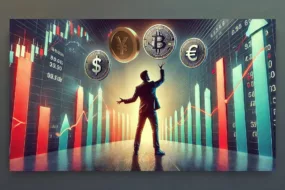
TL;DR
- Thematic investing is where instead of picking individual assets, you invest in a theme. This way, rather than placing all your capital in a handful of cryptos, you diversify within a theme and increase your chances of returns.
- It involves taking a long-term view of factors like trends, novel ideas, your beliefs and values as well as the general public’s, disruptive themes, etc. Some themes worth investing in are rapid urbanization, climate change, changing economic landscape, etc.
- The benefits of thematic investing include ease of execution, building a powerful portfolio, and of course, high returns.
- You can start investing thematically with exchange-traded funds (ETFs). These are funds that mimic a basket of stocks/cryptos.
- To manually build your own thematic portfolio, you first need to research themes, allocate funds appropriately, and rebalance periodically. Coin Sets are one way to execute thematic investing easily.
Introduction
It’s really hard to learn about investing in general. Once you cram up all those thumb rules, you realize that ‘knowing’ was just one of the steps. This is followed by research, shortlisting, and finally, investing in a cryptocurrency. And if you thought that’d be the end of it, wait! There’s more. Who would rebalance your portfolio based on the market updates? Sounds like you? This one is just for you.
Thematic investing is a form of investing where instead of picking individual assets or sectors, you invest on a theme. So how do you go about it? What are the pros and cons of this form of investing? And how exactly can you make the most of this style? We’ll find out today!
What Is Thematic Investing?
Thematic investment is a shortcut mode of getting exposure to an asset class. Let us take this up with an example. Say that you are a regular investor who does not have the time or patience to find the best stocks to buy. However, given your field of work or general observation, you believe EVs will be the next big thing within the next five years.
So, instead of wasting time finding out the companies that would benefit from the EV revolution, what if there was a way to invest in a basket of stocks that focussed on EVs? As you can imagine, this would include automobile manufacturers, battery companies, Lithium manufacturing companies, etc.
In other words, you just bet on a theme instead of individual companies. And because you are now taking a punt on a theme, it is likely to play out in a longer duration. In this case, you are likely to evaluate the factors that may impact the revenue of the companies under a theme. For example, rather than evaluating what Ola Electric is doing, you could be interested in understanding the government’s subsidy for EVs.
Generally put, as a thematic investor, you are likely to pay more attention to geopolitical, macroeconomic, and technological trends.
How Does Thematic Investment Work?
Thematic investing involves taking a long-term view of the following factors:
1. Trends
Do not worry about the daily ups and downs of an asset. Rather try to evaluate its overall performance over a period of time. For example, I am very bullish on the food delivery theme in the Indian Market.
Now ask yourself.
Household incomes are growing.
With both spouses working, no one is likely to cook after coming back home.
Parking is a hassle in bigger cities.
So the delivery option hits that sweet spot. So I believe it is likely to go up. Similarly, you can pick a theme and evaluate its future by asking such questions.
2. Ideas
In the same example, what if these delivery executives are horizontally deployed to some other task? Can they also deliver parcels? What if we used them for delivering groceries? Such ideas can help in a deeper understanding of a theme and its future outcomes.
3. Beliefs and values
Now you need to ask yourself about the general reception of the audience towards a theme. For example, if you are betting on the meat industry in a country, try to find out what the consumers think. Are they moving toward veganism? Or have more people started consuming non-vegetarian each day?
At the same point, you can also take a stance based on your personal beliefs and values.
For example, the theme of ESG or Environment, Social and Governance compliant companies has really taken off in recent times. People who feel that sustainability aligns with their core set of values are investing in such themes.
4. Disruption
And then, of course, the themes that are likely to disrupt the industry are always trending. For example, blockchain is a theme that is currently touching businesses across verticals. From supply chain to finance, manufacturing and marketing, blockchain is disrupting everything.
What Are The Benefits of Investing Thematically?
Now a bigger question. Are there some real benefits of investing thematically? Or is it another fancy influencer-hyped technique? Turns out that your portfolio can actually become stronger and smarter with thematic investment. Let’s talk about this in detail.
1. Portfolio structure
Let us face it. Investing is hard. Imagine fundamentally analyzing a petrochemical company while you are a graphic designer. Would you be passionate enough to do that? On the flip side, thematic investing allows you to take a call on future trends based on topics that specifically align with your ideologies. This helps you build a powerful portfolio structure.
Another benefit of this is that you are naturally inclined to learn more about the theme without money being a motivator.
2. Easy
Thematic investing is comparatively easy as compared to traditional forms of money-making. Apart from the passion, interest, and knowledge you carry about a theme, you can also have an outsider viewpoint on multiple themes based on your understanding. Imagine someone taking a bet on the healthcare industry during the onset of the pandemic. All such stocks grew multifold.
3. Higher returns
As a thematic investor, you are trusting your instincts to bet on a theme. This is in contrast to a mutual fund where the fund manager relies on their knowledge to invest your money. Because you already have an alpha regarding a particular theme, you are likely to beat the other modes of investment.
What Are The Examples of Thematic Investments?
To better understand the thematic way of investing, let us quickly explore a few examples. These examples have been taken from BlackRock’s thematic investing philosophy. For the uninitiated, BlackRock is one of the world’s largest brokerage firms.
Its philosophy includes investing in megatrends that are driven by technological disruption.
Some examples include:
- Rapid urbanization
- Climate change and depleting natural resources
- Changing economic landscape
- Demographic and social changes
How to Start Investing Thematically?
One of the quickest ways to invest thematically is through ETFs.
ETFs are exchange-traded funds that track or mimic a basket of stocks/cryptos. They are like mutual funds that can be sold and bought like stocks on an exchange. For example, if you wish to track all Indian blue chip companies, you can purchase an ETF that tracks the NIFTY 50 index.
There are also many thematic ETFs such as FINX, which invests in Fintech, BOTZ, which invests in robotics/AI, and ICLN, which provides exposure to renewable-energy-focused stocks.
Other than that, if you wish to get into crypto-related thematic investments, Coin Sets by Mudrex is a great tool. It simply takes the load off your shoulders as these baskets are handled and rebalanced periodically by experts. All you have to do is invest.
How to Manually Build Thematic Portfolio?
Well, if you are reading this, I can assume that thematic investing has your interest. So let us delve deeper into it by understanding how you can build a thematic portfolio. What are the steps involved?
1. Discovering themes and categories
Pro tip: If you pick up a theme that resonates with your interest area, you are likely to research better.
This step involves picking a broader category to invest in. For example, you could pick fintech in India as the government is quite bullish on it. You could also pick robotics, AI, and blockchain, as these are novel technologies that are likely to become mainstream.
Within the cryptocurrency realm, you could stick to Blue Chip Cryptocurrencies. Alternatively, you could bet on Metaverse tokens as they are being pursued by the world’s largest social media company,- Meta.
If you feel that Ethereum is too slow and layer 2 scaling solutions (parallel blockchain solutions that help in the scalability), you could invest in a bunch of them.
2. Research and decision
Now that you’ve shortlisted a few themes, it is time to compare them with one another. You can compare them based on volatility, maturity, government stance, demand, etc.
For example, currently, crypto, just like every other asset class, is going through tough times due to fed tightening (federal bank pulling out liquidity from the market). In such a scenario, it would be smarter to bet on Blue Chip Cryptocurrency to accumulate them as they are available for a discount.
On a similar note, in the case of stock markets, one could bet on companies that are likely to benefit from the growth of the middle class in India. As the per capita income increases, these companies are likely to be the first benefactors of it.
Now, if I were to compare this with an EV-based theme, I would rate the middle-class theme higher because EVs will still undergo a disruption phase where the tech would further evolve. Apart from that, there is a learning curve for all the buyers, which is not the case with middle-class spends.
3. Managing weights
Once you have shortlisted the themes, it is time to pick the companies that fall under this theme. And while you are creating that list, is it smart to assign each of these companies a similar weightage?
If you consider crypto, Enjin and Sandbox fall under the same theme of Metaverse. But given the maturity, Enjin is far behind Sandbox, which has a monthly active user base of 300,000 users.
Therefore, you need to assign weights to each of the individual companies. Weight is defined as the total percentage of the amount being invested in each company.
Say a themed portfolio costs about $1000. If company A has a weight of 20%, it means that you are purchasing stocks/crypto worth $200 for that company.
This can be done in either of two ways:
3. 1. Market-cap-weighted
In this method, you simply allocate the weights in the rank of the market cap of a crypto/company. This ensures that larger and proven companies form a bigger part of your portfolio while the smaller ones still exist.
For example, a themed portfolio consisting of Bitcoin, Ethereum, Solana, and Polygon can have the weights in line with the market dominance (crypto asset market cap/ total market cap of the industry).
So Bitcoin can occupy roughly 50%, Ethereum can take another 25%, Solana at 15%, and Polygon at 10%.
3. 2. Risk-weighted distribution
Contrary to the market cap, a risk-weighted distribution takes into account the risk of assets. This can be done using various data points like volatility, regulatory risks, total debts, etc.
In this approach, you are likely to assign a higher rank to the asset which is least risky.
4. Rebalance
Now that everything is done and dusted, all we need to do is revisit our portfolio periodically and rebalance it as per our initial vision. This is done to make sure that we optimize for maximum profits. During rebalancing, one is likely to change the weights and add/delete some of the crypto/companies in a theme.
Conclusion
We believe thematic investing to be the go-to mode for investing in today’s fast-paced world. Not only does it save you time, but it also keeps you on top of global events that impact your portfolio. It is a generalist approach to investing which can be leveraged by any individual.
FAQs
1. What is the difference between thematic and impact investing?
Thematic investments focus on the area rather than the effect to be achieved. For example, say you invest in a sustainability cause that aims to provide drinking water to underprivileged children in Africa. Here, your funds may or may not be used for making water accessible for those kids. It could be used in other areas as well.
On the other hand, impact investing focuses completely on the effect rather than the area. If someone is impact investing in a similar theme, they’re ensuring that their funds would directly impact the cause by providing water.
2. Is it worth investing thematically?
Yes. Thematic investment has been leveraged by some of the largest fund houses in the world. This allows its investors to save time and invest in a cause that they truly believe in. This aligns your intent and finances in the same direction.
3. How many thematic ETFs are there?
Multiple thematic ETFs allow investors to take part in various themes. Some of the key examples are FINX which invests in Fintech, BOTZ, which invests in robotics/AI, and ICLN, which provides exposure to renewable-energy-focused stocks.





